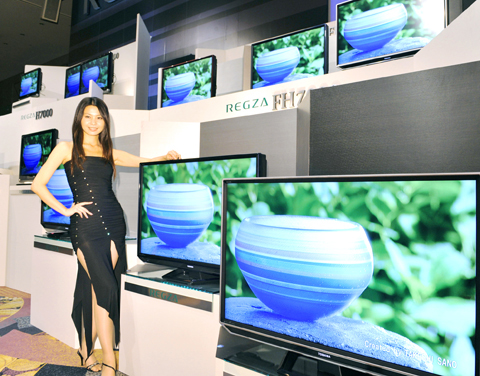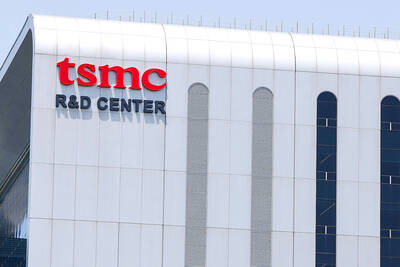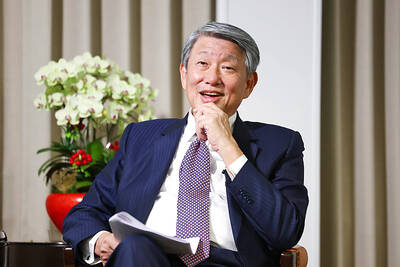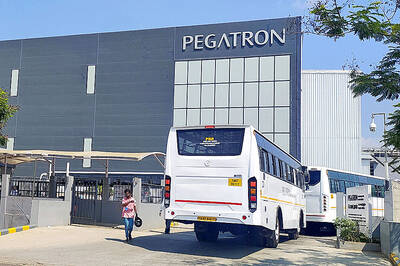Prices for liquid-crystal-display (LCD) panels may hold steady in the first half of this month after constant price declines have eaten into the bottom line of certain suppliers, ending the downward spiral that began in June, market researcher DisplaySearch’s latest report said.
But, price pressure may remain in place this month with no marked recovery in demand.
PC and monitor vendors may become conservative about panel purchases after they posted slower-than-expected sales as corporations and consumers cut PC spending amid a weaker global economy, the Austin, Texas-based researcher said.

PHOTO: AFP
“There will be some stabilization in panel prices in the first half of October, because prices are down to the cost lines and panel makers are operating with losses, leaving limited room for further price reduction,” DisplaySearch said in a report released on Saturday.
Mainstream 19-inch LCD panels for PC monitors are expected to be unchanged at US$80 per unit, the same as in the second half of last month, following a 36 percent decrease over the previous four months since mid-June because of a supply glut, the report indicated.
In July, major LCD panel makers, including the world’s second-largest panel maker LG Display Co Ltd, said they planned to cut output by 10 percent to 15 percent to ease oversupply as demand weakened suddenly.
Morgan Stanley LCD industry analyst Frank Wang (王安亞) projected Chi Mei Optoelectronics Corp (奇美電子), the nation’s second-biggest LCD panel supplier, may drift into quarterly losses in the third quarter, the first quarterly losses in almost two years, as prices dropped faster than expected because of excessive inventories.
Bigger rival AU Optronics Corp (友達光電) may swing into quarterly loss later in the final quarter of the year, Wang said.
He expected the LCD industry to bottom out in the first quarter of next year before a V-shaped recovery arrives in the second half of next year, his report dated Sept. 24 said.
Prices for mainstay television panels are also expected to slide about 3.9 percent to US$245 per unit in the first two weeks of the month from the last two weeks of last month, smaller than the 5.6 percent decline in the previous two weeks, the report released by DisplaySearch said.
Supply in the mainstay 32-inch LCD panels would remain loose as TV vendors were conservative about ordering panels after TV set demand had not picked up as expected, the researcher said.
Panel makers may continue to feel a lot of pressure to lower prices for TV panels, DisplaySearch said.

The Eurovision Song Contest has seen a surge in punter interest at the bookmakers, becoming a major betting event, experts said ahead of last night’s giant glamfest in Basel. “Eurovision has quietly become one of the biggest betting events of the year,” said Tomi Huttunen, senior manager of the Online Computer Finland (OCS) betting and casino platform. Betting sites have long been used to gauge which way voters might be leaning ahead of the world’s biggest televised live music event. However, bookmakers highlight a huge increase in engagement in recent years — and this year in particular. “We’ve already passed 2023’s total activity and

BIG BUCKS: Chairman Wei is expected to receive NT$34.12 million on a proposed NT$5 cash dividend plan, while the National Development Fund would get NT$8.27 billion Taiwan Semiconductor Manufacturing Co (TSMC, 台積電), the world’s largest contract chipmaker, yesterday announced that its board of directors approved US$15.25 billion in capital appropriations for long-term expansion to meet growing demand. The funds are to be used for installing advanced technology and packaging capacity, expanding mature and specialty technology, and constructing fabs with facility systems, TSMC said in a statement. The board also approved a proposal to distribute a NT$5 cash dividend per share, based on first-quarter earnings per share of NT$13.94, it said. That surpasses the NT$4.50 dividend for the fourth quarter of last year. TSMC has said that while it is eager

CUSTOMERS’ BURDEN: TSMC already has operations in the US and is a foundry, so any tariff increase would mostly affect US customers, not the company, the minister said Taiwanese manufacturers are “not afraid” of US tariffs, but are concerned about being affected more heavily than regional economic competitors Japan and South Korea, Minister of Economic Affairs J.W. Kuo (郭智輝) said. “Taiwan has many advantages that other countries do not have, the most notable of which is its semiconductor ecosystem,” Kuo said. The US “must rely on Taiwan” to boost its microchip manufacturing capacities, Kuo said in an interview ahead of his one-year anniversary in office tomorrow. Taiwan has submitted a position paper under Section 232 of the US Trade Expansion Act to explain the “complementary relationship” between Taiwan and the US

Pegatron Corp (和碩), an iPhone assembler for Apple Inc, is to spend NT$5.64 billion (US$186.82 million) to acquire HTC Corp’s (宏達電) factories in Taoyuan and invest NT$578.57 million in its India subsidiary to expand manufacturing capacity, after its board approved the plans on Wednesday. The Taoyuan factories would expand production of consumer electronics, and communication and computing devices, while the India investment would boost production of communications devices and possibly automotive electronics later, a Pegatron official told the Taipei Times by telephone yesterday. Pegatron expects to complete the Taoyuan factory transaction in the third quarter, said the official, who declined to be